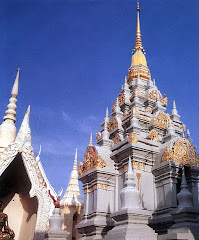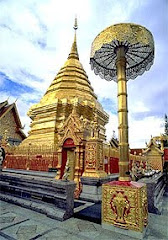
The construction of the Royal Pantheon commenced in the year 1855, the first year of King Rama IV's regin. He intended to use it for the enshrinement of the Emerald Buddha. However, it was not completed until after his death, and his successor, King Rama V, did not move the palladium to the new building which he considered too small to accomodate the congregation at royal ceremonies. A Small gilt stupa belonging to King Rama IV was placed there instead.
The Royal Pantheon was built on a cruciform plan with four porticoes and a corncob shaped tower-like superstructure known as "prang", in 1903 the gilt stupa together with part of the edifice was destroyed by fire. After the repair of the building King Rama IV, the then reigning king, mde use of it as the Royal Pantheon of the Chakri Dynasty, bestowing on it the name Prasat Phra Thep Bidon (meaning the Shrine of the Celestial Ancestors). Life-size statues of the five preceeding kings from King Rama I to King Rama V were initially installed: those of King Rama VI, King Rama VII and King Rama VIII were installed later, after their deaths, and the Royal Pantheon was opened to the public to pay homage to their past sovereigns on April 6, the anniversary of the Founding of the Chakri Dynasty. The Royal Pantheon is noted for its eye-catching gilt lacquer angel-motif designs on the outer panels of the doors and windows, and for the decorative motif based on the emblems of each of the first five sovereigns of the Dynasty on the side panels of the outer recesses of the doors and windows. On the lintels are stucco gold designs composed of royal decorations.
Inside the Royal Pantheon, stands the mother-of-pearl inlaid cabinet for the canonical texts. The cabinet with its tiered roof is one of the most exquisite examples of the early Rattanakosin work of art whose creator, one of King Rama I's highest ranking courtiers, evidently strove to rival the best of Ayutthaya inlay workmanship. The dimensions of the cabinet in relation to those of the doorways of the building shows conformation to the convention of making the scripture cabinets larger than the exits so that thaey could not be removed from the place where they rightly belonged.
source:http://www.geocities.com/RainForest/7153/pakao9.html
photo credit :oceansmile
Related tags : wat phra kaew/wat thai/Bangkok/Thailand Temple/Royal Pantheon
Monday, September 10, 2007
Prasat Phra Thep Bidon (The Royal Pantheon) :Wat Phra Kaew
Posted by
myplot'blog
at
9:22 PM
1 comments
![]()
Labels: Bangkok, temple, Thailand, wat phra kaew, wat thai
Wat Phra Lao Thep Nimit : Amnat Charoen Province


Wat Phra Lao Thep Nimit is on Highway 2049 about 2 kilometers from Amphoe Phana centre. It is an old temple. Phra Lao Thep Nimit, an ancient Buddha image, is houses in the beautiful ordination hall is about 200 years old. The Ubosot (convocation hall) is of the Lanna architectural style .The principal sacred Buddha image, in the attitude of Subduing Mara is lacquered and gilded.
source:Tourism Authority of Thailand
photo:thai-tour
Related Tags: Buddha Image/temple/thai temple/wat/Wat Thai
Posted by
myplot'blog
at
8:46 PM
0
comments
![]()
Labels: Amnat Charoen, Buddha image, Buddhist temples, temple, wat thai








